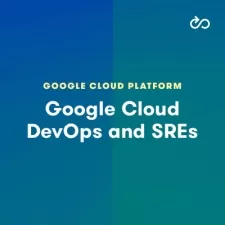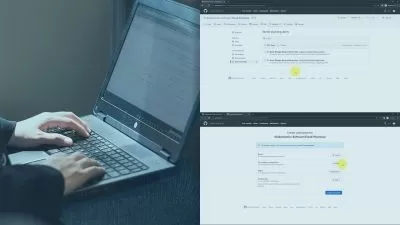Real-Time Corporate CI/CD DevOps Pipeline Project - Hands On
Shikhar Verma • 60k+ Students Worldwide
3:53:53
Description
100% hands-on labs on deploying appl through DevOps CI/CD pipelines using Git, Jenkins, Trivy, Maven, Sonar, Docker, K8s
What You'll Learn?
- Set up a Kubernetes cluster in an AWS environment
- Security scan by KubeAudit on Kubernetes cluster
- Set up VM's for DevOps tools
- Customize the Jenkins
- Jenkins pipeline job to check out the project
- Compile and run unit test cases on source code
- Trivy tool - Vulnerability Scan on Source Code
- SonarQube - Code quality tool for better code
- Build the package: Using maven tool
- Push the artifact to the Nexus Repository
- Build and Tag the Docker Image
- Docker Image Scanning by Trivy tool
- Deploy the application to a K8s cluster environment
- Monitoring using Prometheus and Grafana
Who is this for?
What You Need to Know?
More details
DescriptionIf you are familiar with various DevOps tools like Git, Jenkins, Maven, Trivy, Ansible, Docker, and Kubernetes but are unsure of how they work together, then using them would be pointless or,
Would you like to establish a comprehensive CI/CD pipeline utilizing a variety of DevOps tools? or,
If you are interested in understanding the logical workflow of a DevOps project, then this course is designed for you.
Course Content:
Section 1: Introduction
-> Introduction
-> Course Overview
Section 2: Set up a Kubernetes cluster in an AWS environment
-> Overview of the Kubernetes cluster created with Kubeadm
-> Create three VMs: one master and two worker nodes
-> Access the VMs using MobaXterm software
-> SSH from the master node to the worker node using a private key
-> Set the hostname, update the hosts file, and disable swap
-> Install a container runtime
-> Install kubeadm,kubelet and kubectl
-> Initialize the K8s cluster
-> Troubleshooting the Kubernetes clusture issue
-> Join worker nodes to the cluster
Section 3: Security scan by KubeAudit on Kubernetes cluster
-> Overview of security scan by kubeaudit
-> Download and install kubeaudit
-> Use kubeaudit to scan the manifest file
-> Use kubeaudit to scan the cluster
-> Use kubeaudit to scan the local
Section 4: Set up VM's for Jenkins,Nexus,Maven,and SonarQube tools
-> Create VM's for SonarQube & nexus
-> Install SonarQube using docker-1
-> Install SonarQube using docker-2
-> Access the SonarQube server through the web URL
-> Install nexus using docker-1
-> Install nexus using docker-2
-> Access the Nexus server through the web URL
-> Create a VM for Jenkins server
-> Install Jenkins on an Ubuntu virtual machine
-> Install Jenkins server through the web URL
-> Customize the jenkinsÂ
Section 5: Git Bash and GitHub
-> Create a private repository on GitHub
-> Install Git Bash and then clone the repository
-> Push the source code to a GitHub repository
Section 6: Customize the Jenkins
-> Installing the required plugins on the Jenkins server
-> Configure tools:JDK,sonarqube scanner,maven,docker
Section 7: Create a Jenkins pipeline job to check out the project
-> Create a job on Jenkins
-> Create credentials to access a private GitHub repository
-> Pipeline to checkout the project
Section 8: Compile and run unit test cases on source code
-> Compile the source code
-> Run unit test cases
Section 9: Trivy tool - Vulnerability Scan on Source Code
-> Download and Install Trivy tool
-> Vulnerability scan by Trivy using CICD pipeline
Section 10: SonarQube - Code quality tool for better code
-> Configure SonarQube server
-> Add a stage to the CI/CD pipeline for SonarQube analysis
-> Build the SonarQube job
-> Wait for SonarQube analysis
-> Add a stage WaitforQualityGate to the CI/CD pipeline
Section 11: Build the package: Using maven tool
-> Build the package
Section 12: Upload the artifact to the Nexus Repository
-> Overview of Sonatype Nexus Repository
-> Add a Global maven setting.xml from managed files
-> Add a stage Publish the Artifact into Nexus Repository
-> Build the job-Publish the artifact
Section 13: Build and Tag the Docker Image
-> Build and tag docker image
-> Create a dockerfile
-> Add an entry for Maven snapshots in the pom.xml file
-> Build the Job
Section 14: Docker Image Scanning by Trivy tool
-> Docker Image Scanning by Trivy tool
Section 15: Push the docker image to DockerHub
-> Push the docker image to DockerHub
Section 16: Deploy the application to a Kubernetes cluster environment
-> Create a service account on cluster
-> Create a role and bind it with the Service Account on Cluster
-> Create a authorized token
-> Add a stage to deploy the docker image to K8s Cluster
-> Create a deployment & service yaml file
-> Install kubectl,kubeadm,and kubelet in Jenkins server
-> Build the job
Section 17: Monitoring with Prometheus and Grafana
-> Download and install Prometheus
-> Download and install Grafana
-> Download and install blackbox exporter
-> Edit the prometheus.yml file and add the necessary entry
-> Access Prometheus by using the URL to reach the target
-> Visualize the application data using Grafana
-> Install plugins on Jenkins for system metrics
-> Monitor server metrics using Prometheus with Node Exporter
-> Visualize the server metric data using Grafana - 1
-> Visualize the server metric data using Grafana - 2
-> Last Lecture
Who this course is for:
- Beginners in the world of CI, CD, and DevOps who are interested in establishing a solid foundation in the fundamental concepts.
- Interested in learning about DevOps workflow.
If you are familiar with various DevOps tools like Git, Jenkins, Maven, Trivy, Ansible, Docker, and Kubernetes but are unsure of how they work together, then using them would be pointless or,
Would you like to establish a comprehensive CI/CD pipeline utilizing a variety of DevOps tools? or,
If you are interested in understanding the logical workflow of a DevOps project, then this course is designed for you.
Course Content:
Section 1: Introduction
-> Introduction
-> Course Overview
Section 2: Set up a Kubernetes cluster in an AWS environment
-> Overview of the Kubernetes cluster created with Kubeadm
-> Create three VMs: one master and two worker nodes
-> Access the VMs using MobaXterm software
-> SSH from the master node to the worker node using a private key
-> Set the hostname, update the hosts file, and disable swap
-> Install a container runtime
-> Install kubeadm,kubelet and kubectl
-> Initialize the K8s cluster
-> Troubleshooting the Kubernetes clusture issue
-> Join worker nodes to the cluster
Section 3: Security scan by KubeAudit on Kubernetes cluster
-> Overview of security scan by kubeaudit
-> Download and install kubeaudit
-> Use kubeaudit to scan the manifest file
-> Use kubeaudit to scan the cluster
-> Use kubeaudit to scan the local
Section 4: Set up VM's for Jenkins,Nexus,Maven,and SonarQube tools
-> Create VM's for SonarQube & nexus
-> Install SonarQube using docker-1
-> Install SonarQube using docker-2
-> Access the SonarQube server through the web URL
-> Install nexus using docker-1
-> Install nexus using docker-2
-> Access the Nexus server through the web URL
-> Create a VM for Jenkins server
-> Install Jenkins on an Ubuntu virtual machine
-> Install Jenkins server through the web URL
-> Customize the jenkinsÂ
Section 5: Git Bash and GitHub
-> Create a private repository on GitHub
-> Install Git Bash and then clone the repository
-> Push the source code to a GitHub repository
Section 6: Customize the Jenkins
-> Installing the required plugins on the Jenkins server
-> Configure tools:JDK,sonarqube scanner,maven,docker
Section 7: Create a Jenkins pipeline job to check out the project
-> Create a job on Jenkins
-> Create credentials to access a private GitHub repository
-> Pipeline to checkout the project
Section 8: Compile and run unit test cases on source code
-> Compile the source code
-> Run unit test cases
Section 9: Trivy tool - Vulnerability Scan on Source Code
-> Download and Install Trivy tool
-> Vulnerability scan by Trivy using CICD pipeline
Section 10: SonarQube - Code quality tool for better code
-> Configure SonarQube server
-> Add a stage to the CI/CD pipeline for SonarQube analysis
-> Build the SonarQube job
-> Wait for SonarQube analysis
-> Add a stage WaitforQualityGate to the CI/CD pipeline
Section 11: Build the package: Using maven tool
-> Build the package
Section 12: Upload the artifact to the Nexus Repository
-> Overview of Sonatype Nexus Repository
-> Add a Global maven setting.xml from managed files
-> Add a stage Publish the Artifact into Nexus Repository
-> Build the job-Publish the artifact
Section 13: Build and Tag the Docker Image
-> Build and tag docker image
-> Create a dockerfile
-> Add an entry for Maven snapshots in the pom.xml file
-> Build the Job
Section 14: Docker Image Scanning by Trivy tool
-> Docker Image Scanning by Trivy tool
Section 15: Push the docker image to DockerHub
-> Push the docker image to DockerHub
Section 16: Deploy the application to a Kubernetes cluster environment
-> Create a service account on cluster
-> Create a role and bind it with the Service Account on Cluster
-> Create a authorized token
-> Add a stage to deploy the docker image to K8s Cluster
-> Create a deployment & service yaml file
-> Install kubectl,kubeadm,and kubelet in Jenkins server
-> Build the job
Section 17: Monitoring with Prometheus and Grafana
-> Download and install Prometheus
-> Download and install Grafana
-> Download and install blackbox exporter
-> Edit the prometheus.yml file and add the necessary entry
-> Access Prometheus by using the URL to reach the target
-> Visualize the application data using Grafana
-> Install plugins on Jenkins for system metrics
-> Monitor server metrics using Prometheus with Node Exporter
-> Visualize the server metric data using Grafana - 1
-> Visualize the server metric data using Grafana - 2
-> Last Lecture
Who this course is for:
- Beginners in the world of CI, CD, and DevOps who are interested in establishing a solid foundation in the fundamental concepts.
- Interested in learning about DevOps workflow.
User Reviews
Rating
Shikhar Verma • 60k+ Students Worldwide
Instructor's Courses
Udemy
View courses Udemy- language english
- Training sessions 74
- duration 3:53:53
- Release Date 2024/10/03











